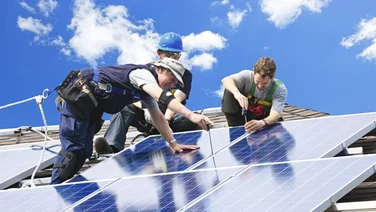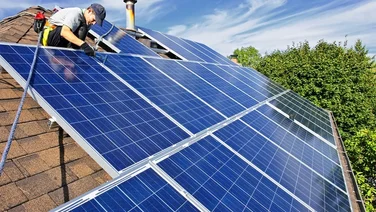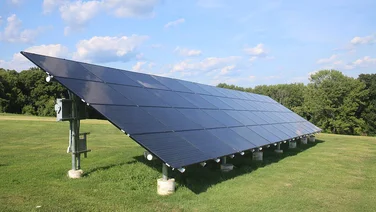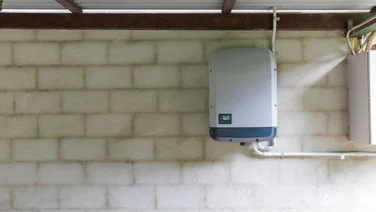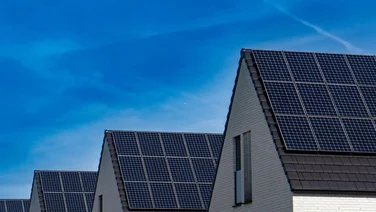- Can solar panels be mounted on a wall?
- Are wall-mounted solar panels as effective as roof-mounted solar panels?
- Which properties are most suited to wall-mounted solar panels?
- How much do wall-mounted solar panels cost?
- How long does it take for wall-mounted solar panels to be installed?
- Should you get wall-mounted solar panels?
- Next steps
- Frequently Asked Questions
- Wall-mounted solar panels work best on south-facing walls
- The panels can be installed parallel to the wall or at a tilt
- Wall-mounted panels aren’t usually as efficient as roof-mounted ones
If you can’t put solar panels on your roof, don’t worry, this doesn’t mean you can’t install them at all. Even though the cost of roof-mounted solar panels tends to be lower, wall-mounted solar panels can still be a handy way for homeowners to benefit from solar power.
But are they the right option for you? In this article, we’ll explore the pros and cons of wall-mounted solar panels, the costs involved, their effectiveness, and which properties are best suited to them.
If you want to find out how much solar panels will cost you first, just fill in our quick form. We’ll pass your details on to professional solar panel installers, who’ll contact you with tailored quotes.
Where do you want to install solar panels?
Get started
Can solar panels be mounted on a wall?
Yes, solar panels can be mounted on a wall, either attached parallel to it, tilted at an angle, or hung as a canopy.
This is usually a good option for properties with an unsuitable roof for solar panels – whether it’s because of poor structural integrity or excessive shade.
Tilting solar panels at an angle is usually the best way to ensure they get enough sunlight. The best angle for solar panels is between 20 and 50 degrees, which is difficult to achieve when solar panels are mounted on a wall – even if they are titled.
Where possible, wall-mounted panels should be titled to a 60-degree angle, which is the optimal angle for capturing sunlight when the sun is low in the sky.
It’s also best to place wall-mounted solar panels on a south-facing wall, as this will expose them to the most direct sunlight throughout the day.
So, although it is possible to mount solar panels on a wall, it’s not ideal. You’re also less likely to be able to mount as many solar panels on a wall as you would on a roof, which means they won’t generate as much electricity as a roof-mounted system.
What are the pros and cons of wall-mounted solar panels?
- Allows properties that can’t put panels on their roof to still use solar energy
- Easier to clean and maintain than roof-mounted solar panels
- Generate more electricity during the winter than roof-mounted solar panels
- Often don’t generate as much electricity overall as roof-mounted solar panels
- Can be more expensive to install than roof-mounted solar panels
- Wall-mounted panels need special anchors to be installed safely
The advantages of wall-mounted solar panels
Although they won’t harness as much energy as roof-mounted panels, wall-mounted systems allow people to introduce more green energy to their home, even if their roof isn’t strong enough for solar panels.
They can also provide supplemental energy if the homeowner has run out of space for panels on the roof.
Wall-mounted panels are also easier to clean and maintain than roof-mounted panels. Their steep angle means they won’t accumulate as much dust and debris.
Another benefit of having a steep angle is that it means wall-mounted panels work better in the winter, when the sun is lower in the sky, than roof-mounted panels. This is especially useful for homes in the UK, which tend to use more energy in the winter.
The disadvantages of wall-mounted solar panels
In most cases, wall-mounted solar panels won’t be able to generate as much electricity throughout the year as roof-mounted systems, especially during the summer, when the sun stays higher in the sky for longer.
This is because, despite their steep angle coming in handy during the winter, it can hinder performance during the rest of the year.
Wall-mounted solar panels can also be more expensive to install than roof-mounted systems because they require extra strong anchors to keep them securely attached. Installers will also probably have easier access to the roof – especially on flat roofs where they can walk about.
It’s also worth bearing in mind that most properties are unlikely to be able to install a whole set of solar panels onto their wall, since a three-bedroom house will typically need 10 panels.
Where do you want to install solar panels?
Get started
Are wall-mounted solar panels as effective as roof-mounted solar panels?
Wall-mounted solar panels are usually less effective than roof-mounted systems because they often have a steeper angle, so they don’t receive as much sunlight throughout the day.
Roof-mounted solar panels are usually titled at a 20-50 degree angle, which allows them to capture sunlight when the sun is high in the sky. But most wall-mounted panels are parallel to the wall, or only slightly tilted.
It’s also harder to fit as many solar panels on a wall as you would on a roof. A typical three-bedroom house can fit around 10 350-watt (W) panels on its roof, whereas a wall will only fit around two or three panels.
A roof-mounted solar system of this size can generate around 2,645 kilowatt hours (kWh) a year in the UK, whereas a wall-mounted system with three 350 W panels would only produce 0.738 kWh a year.
Wall-mounted panels are also more likely to be exposed to shade from trees or neighbouring buildings than roof-mounted ones, which would further reduce their effectiveness.
Which properties are most suited to wall-mounted solar panels?
Properties that are most suited to wall-mounted solar panels are ones that have large south-facing walls, which aren’t covered by any shade.
South-facing panels are exposed to sunlight throughout the day, which is especially handy for wall-mounted solar panels, given their performance is already hindered by their limited angle.
It’s also important for the property to have large enough walls to fit as many solar panels as possible, which need to be installed at the top of the wall to get the maximum amount of sunlight.
No matter how large the wall is though, it’s unlikely it will be large enough to fit enough solar panels to meet all a home’s energy needs. You’ll typically only be able to fit two to four panels, whereas an average home requires 10 panels to fully meet its energy needs.
Buildings will also need to be structurally sound to have wall-mounted solar panels installed, but installers usually make sure of this before starting any work.
And if you live in a listed building, you probably won’t be suitable for wall-mounted solar panels, because it’ll impact the appearance of the building too much. You can read more about installing solar panels on listed buildings in our helpful guide.
Properties in countries at high latitudes, such as the UK, are also better candidates for wall-mounted solar panels than properties in areas closer to the equator. This is because wall-mounted solar panels work best when the sun is lower in the sky, which is the case for longer periods during the winter in countries at high latitudes.
If you have a lot of land space, you could also consider ground-mounted solar panels, or solar panel fences, another type of vertical solar panel system.
How much do wall-mounted solar panels cost?
A homeowner in a typical three-bedroom house in the UK can expect to pay around £7,026 to buy and install a set of roof-mounted solar panels. A wall-mounted system can cost a little more upfront, which is mainly down to the fact that they’re more difficult to install.
This is because wall-mounted panels require special wall anchors to make sure they’re safely installed at a vertical angle. They’re also likely to take longer to install than roof-mounted units, so labour costs will also be a little more expensive.
If you want to find out more about what prices to expect for a solar panel installation, head to our solar panel costs page.
How long does it take for wall-mounted solar panels to be installed?
It’ll usually take two to three days for wall-mounted solar panels to be installed –but this can vary, depending on the size of the property, the number of panels being installed, and the height of the solar panel system.
Installation costs will also take scaffolding into account, since most wall-mounted solar panels will be positioned at the highest point of the wall to make sure they have the best chance of absorbing sunlight.
You can read more about the ins and outs of solar panel installation in our step-by-step guide.
Should you get wall-mounted solar panels?
You should only get wall-mounted solar panels if you have a large south-facing wall, and you’re unable to mount them on your roof.
Since most roofs are already at an angle, they’re usually the optimal place to place solar panels – not to mention they’re the highest point of the property.
But if a property has a heavily shaded roof and unshaded large walls, then wall-mounted solar panels might be a good alternative.
On top of this, if your roof can’t accommodate solar panels – either because it’s too structurally weak or because it doesn’t have enough surface space – then wall-mounted panels might be right for you.
The shape of some roofs – if they’re rounded, or have a lot of ridges or chimneys – can also make installation difficult and expensive. In this case, the walls of the property might be a better spot for solar panels.
Whatever your decision, solar panels are always a good investment. With 69% of Brits saying they’d buy a house with solar panels, according to our National Home Energy survey, it’s likely they will increase the value of your house.
Next steps
If your roof is stopping you from installing solar panels, wall-mounted solar panels might be a good solution.
But bear in mind that they typically don’t produce as much electricity as roof-mounted solar panels, and might not look aesthetically pleasing.
Think you’re ready to install solar panels? We can help. Just fill in our short form, and we’ll pass your details on to our network of solar panel installers. They’ll get in touch and offer you their best prices.
Frequently Asked Questions
Do you need planning permission for wall-mounted solar panels?
You won’t typically need planning permission to install wall-mounted solar panels on a property that you own.
Properties that do require planning permission are listed buildings or buildings in conservation areas, where there are restrictions on the number of changes you can make to the outside of the property.
Is it worth tilting wall-mounted solar panels?
It’s definitely worth titling wall-mounted solar panels where possible, instead of having them be parallel to the wall. The best angle for solar panels is between 20 and 50 degrees – beyond this, electricity production drops off.
This angle is hard to achieve when solar panels are mounted on a wall, but the closer a panel is to a 60 degree angle, the more sunlight it will get when the sun is low in the sky.
How many solar panels does it take to power a house?
The average three-bedroom house in the UK needs around 10 solar panels, that take up 20 square metres, to meet its energy needs.
But of course, this can vary depending on the size of the house and its electricity consumption. The larger a house is, and the more electricity it uses, the more solar panels it will need.
If you want to know more, use our guide to find out how many solar panels you need.

